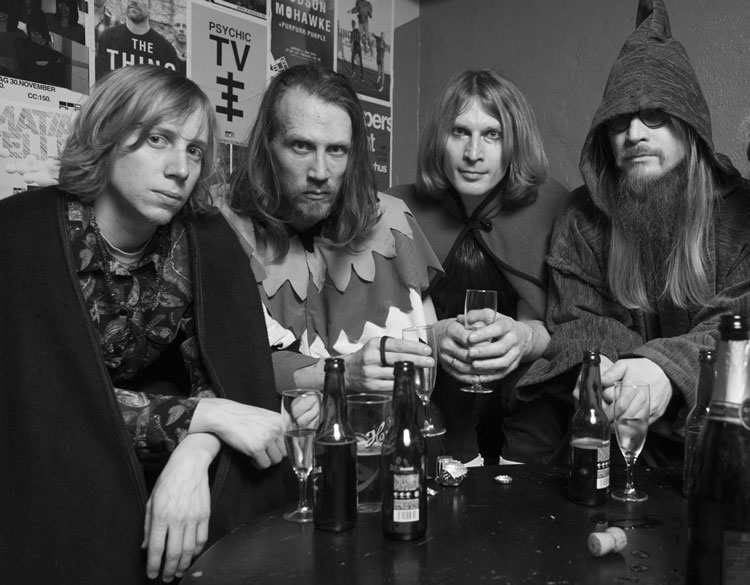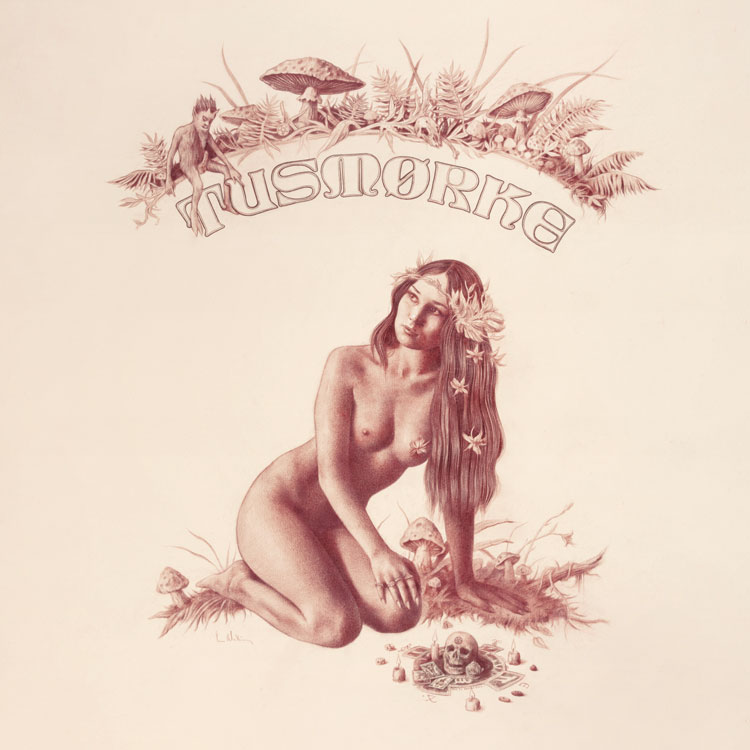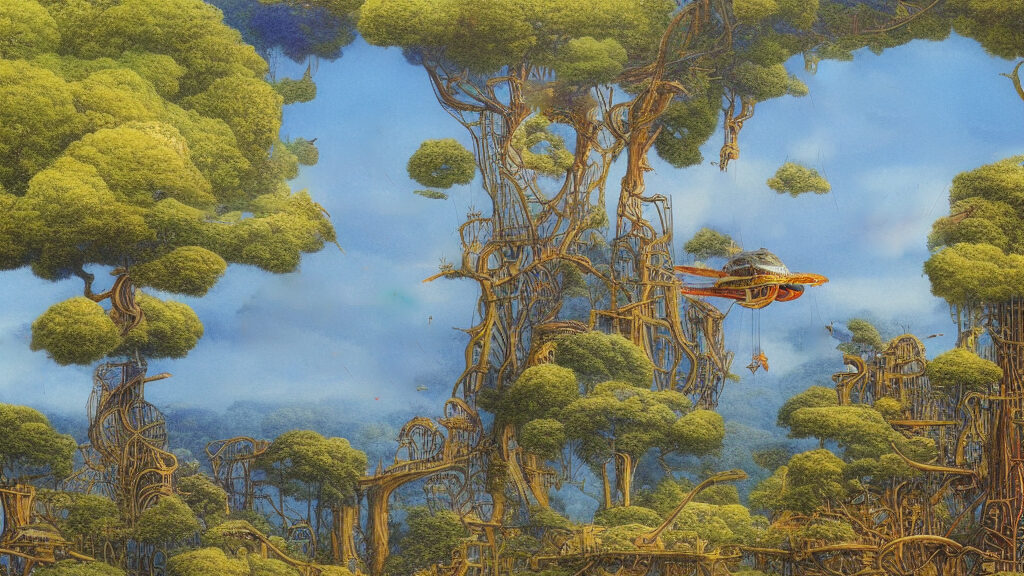Tusmørke is one of the most active and fascinating progressive rock bands in the Norwegian music scene. They combine classic progressive rock, psychedelia, folk influences and a quirky sense of humor. Two of its members, Benediktator and Krizla talked to Progressive Rock Central about their band and their new album, Hestehoven.
What elements do you prioritize in your music-making process?
Benediktator (B:) Above all, the music needs to be done in a certain idiom, so that it feels like it’s ours, like it’s original, even though elements might be inspired or borrowed. I try very hard not to copy other people’s style, which I think is very important if you want to avoid the pitfall of pastiche and retro-repetition. I think I’ll have to go with groove as the most important element, if the music doesn’t make my head nod then I’m doing something wrong. The lyrics are also extremely important, they are either very personal or based on tons of research, ha ha! We seem to gravitate around pretty dark, stark existential topics, dealt with in ways that are simultaneously ridiculous and serious.
Krizla (K): To me, the most important element is whatever hook or riff comes into my head, that I build the song around. It might also be a couple of words for lyrics that fit some kind of melody. Inspiration often comes when I’m not in the studio, like walking somewhere or even biking, so I sing into the recorder on my phone to preserve ideas for later. This involves awkward moments of standing on the roadside singing loudly, but inspiration has priority over social standing.

How has your musical vision evolved from your debut album to your latest recording?
B: The vision remains intact. I always wanted to make albums that would be discovered by weirdo kids at record fairs in the future. For this to work, it is important that the LPs are limited editions and they have to sell quite poorly. So far this is working beautifully.
K: It was always a wish to cultivate a sound that combines the classic vintage prog instruments like mellotron and moog, flute and Rickenbacker with psychedelic and folky kind of melodies. No neck breaking solos or vocal acrobatics, but a repetitive and insisting groove, like in dance music. I think this remains the same.

You have a new album out titled Hestehoven. The press release talks about a strange fairyland. Tell us more about the concept of the album and what it’s about.
B: The strange fairyland is the world of old Norwegian folklore. It has been there for a long time, sometimes hidden, sometimes seen. I grew up believing in elves and remain highly superstitious. Our family originates in Western Telemark where there is a strong tradition of fairy tales and myth; our father studied folklore, scaring us to death with stories of trolls, huldra, deildegasten and the subterraneans. As a child I was also keen on ancient history, dinosaurs and endangered animals; the knowledge that something had been, but was no-more, has always fascinated me. It challenges the notion of what is and what isn’t real; if it once WAS real, why is it no longer possible, no longer part of reality? Does something need to exist physically to count as part of the world?
A lot of children’s shows like Gummi Bears are built on this premise; everyone thinks Gummi Bears are gone, but they are merely hiding, and if you believe, they appear, etc. I really wanted to believe, I guess, and in a way believing in ancient civilizations, hobbits, fairies, hippies, magic, and dinosaurs became part of my (sur)reality.
The album tries to convey the connections between pre-Christian Norse religion, chthonic folklore and Satanism or witchcraft. I think it’s interesting to analyze witchcraft and witch trials as socio-economic rebellion and repression. The Devil is a rebel, sin is disobedience; sometimes it is necessary to fight back. We need to resist neoliberalism and New Public Management, the position of Capitalism today equals that of the Church in pre-modern times. Thinking outside of profit-maximizing is modern heresy. The forces for true change have always been labeled evil or crazy, so to make a change we must embrace evil and craziness, since the so-called good and sane is now destroying the environment with war and pollution. So, this fairyland is not some escapist fantasy, but is a vehicle for a radical sociopolitical message. The erudite scholar Eirik Storesund elaborates on the mythical elements in an essay he wrote for the album, as well.
K: The album touches on the Black book, a collection of spells reputed to be given to people who made a deal with the Devil. The surviving examples of these books are actually quite mundane, containing love charms and ways to cure animal deceases and solve everyday problems in traditional farming society. However, the owners of such books were said to have great powers and were admired and feared. The Devil as provider of knowledge is something that intrigues me very much, as he is the lord of this world but also the enemy of man.
Magic has always been linked to the unexplainable, much that turns out to be simple physics, so that belief in magic is a sign of ignorance rather than possessing secret knowledge. I like to think of secret knowledge and magic as ways of attaining a deeper understanding, not in the sense of explaining phenomena, but to have a different experience of what is going on. Thus, a hole in the ground behind a certain rock may of course be the burrow of a rodent or something, but to me, it is a portal to the land of Faerie. In a sense, living with a magic world view is a kind of willful imbecility.
I enjoyed a medley you inserted of well-known melodies. Why did you choose those specifically?
B: We’ve played around with many different elements in the medley, our various keyboard players The Phenomenon Marxo Solinas, Dauinghorn, Haugebonden Gode Gullstein and Herjekongen have all made new twists during concerts. It started with trying to make the band crack up with throwing in new outrageous parts, so live on stage there has also been Imperial March, Beverly Hills Cop and Norwegian marching band classics. I think this is all done for shits and giggles, really. Lambada is extremely popular in Norway, Romani accordionists play it in the streets and it was a dancefloor hit in youth clubs when we grew up.
K: The little melody from Fiddler on the Roof was added as a spur of the moment thing because it fit with the romping energy of that particular part of the song. The flute build up to that part was influenced by a Beyonce-tune remixed by DJ Spykidelic at a live session on our old radio show Musikk, Dans og Drama that somehow has stuck in my head forever.
What vintage instruments did you use and is it easy to maintain them?
B: The only true vintage stuff I use would be the Ampeg bass amp and Fender Twin Reverb. They break down and need to be fixed, luckily there are skilled people like Sakari at Locomofon around. I also have some Roland Space Echoes, but they don’t leave the studio. The Mellotron is the digital version M4000D and the MiniMoog is the 2016 reissue, so there isn’t a lot to maintain there. Yet. Herjekongen uses a vintage Korg CX3, though, but so far it has been very well behaved.
K: The flute I use, a Muramatsu silver one, is rather ancient and needs regular maintenance.
With progressive rock being underrepresented in mainstream media, how do you go about promoting your music to a wider audience?
B: I used to be very active with promotions on Facebook, but have somewhat lost interest. The situation is a bit odd, I try to stay away from social media but at the same time feel compelled to provide some updates for our followers. I also use Instagram to share fun pictures. All in all, we are not great at reaching a wider audience. We are always game with playing at festivals, though, that is a great way to meet new people.
K: We do get some help from local record shop Big Dipper, they promote every record we release with some kind of event, for which we are very grateful. Also, we have made some memorable videos with film buff extraordinaire Aleksander Serigstad. Norwegian progressive rock is a very vibrant scene, but it mainly gets overlooked, probably because there are no spectacular crimes associated with the musicians involved.
If you could collaborate with any musician or band, who would be at the top of your list?
B: I’m not great at collaborating, I’m far too busy trying to realize my own ideas with the limited time life holds. I love going to concerts, though. My favorite living legends would be Magma.
K: Tusmørke has had quite the roster of talents collaborating with us already, given that the band has been active for so long. Most of my heroes are dead, unfortunately, so I can’t really think of any dream guest.
Can you give us a sneak peek into any upcoming projects you may have in the works?
B: I am mixing two albums currently, featuring material recorded this winter with Kusken, a more jazzy drummer that was with us for 8 months. There will be some contributions from a Oslo-based sauna choir. Also, we have a new drummer now, Brennesle, and are looking forward to start recording with him soon. Some material harks back to when I was 17-18 years old, other songs are brand new, based on jams or random ideas recorded on my phone.
K: I am working on a new album with my solo project Alwanzatar, more of an acid house album for release on 303-day next year. Also, a tape of meditative Buchla-music is in the works. I am constantly working on electronic music beside Tusmørke, and I play with The Chronicles of Father Robin, as well as a heavy metal project called Covens of the Antichrist.
What do you hope listeners will take away from your music and performances?
B: New energy!
K: Bafflement!
Can you share a particularly challenging moment in your musical career, and how you overcame it?
B: We were once stuck in security at Oslo airport because the hurdy-gurdy player tried to bring a bow and arrows in his carry-on luggage. After some discussion he was allowed to pack it into his suitcase, even though it was already checked in. That only left the problem of his chain mail being heavier than the weight allowance. We overcame this problem by firing the hurdy-gurdy player.
K: I fell in a ditch full of thorns once after a concert and lost my glasses and keys, due to overindulgence. I overcame this and similar situations by letting go of alcohol indefinitely. One of my better decisions, highly recommended.
Can you tell us about a memorable performance or concert experience that has stayed with you over the years?
B: Driving to shows in Norway allows us to experience some spectacular scenery; this year we have been to both Hardangervidda and Jotunheimen, which is pretty sweet! I am an avid birder, so sighting cranes, buzzards or ravens along the way really increases my heart-rate!
K: I think the gig at Øktnerhuset in Odalen several years ago will be hard to top. The audience all got undressed and went absolutely crazy dancing and riding around on each other. Pure peasant bacchanalia.

